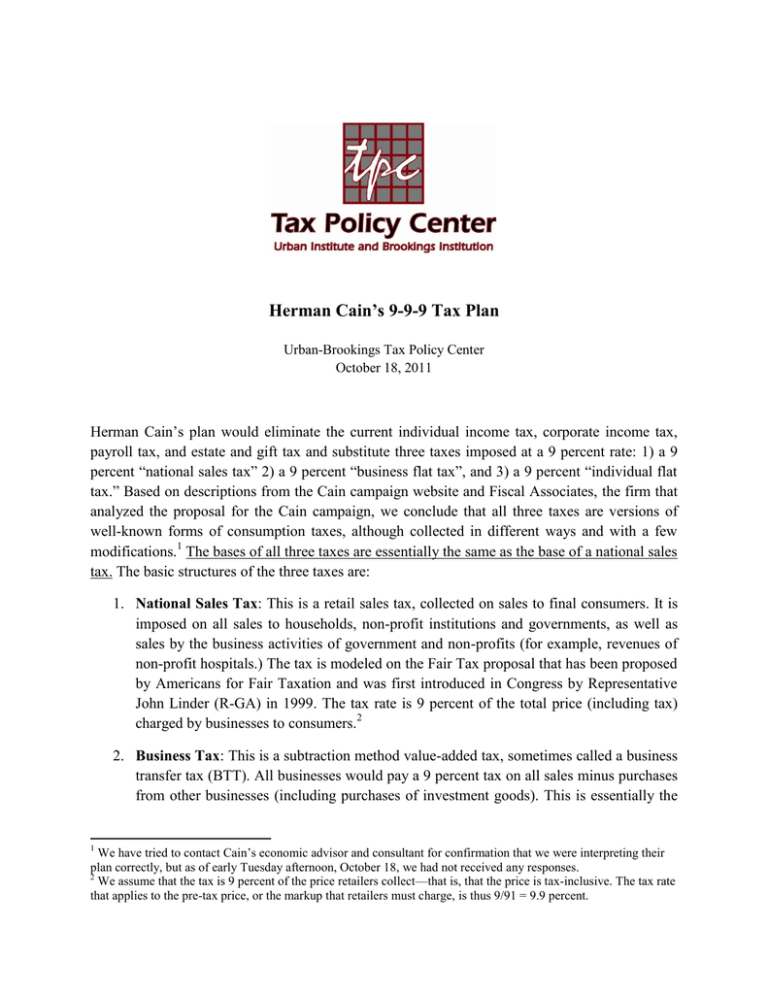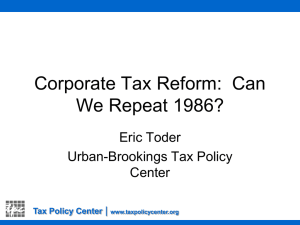Herman Cain’s 9-9-9 Tax Plan
advertisement

Herman Cain’s 9-9-9 Tax Plan Urban-Brookings Tax Policy Center October 18, 2011 Herman Cain’s plan would eliminate the current individual income tax, corporate income tax, payroll tax, and estate and gift tax and substitute three taxes imposed at a 9 percent rate: 1) a 9 percent “national sales tax” 2) a 9 percent “business flat tax”, and 3) a 9 percent “individual flat tax.” Based on descriptions from the Cain campaign website and Fiscal Associates, the firm that analyzed the proposal for the Cain campaign, we conclude that all three taxes are versions of well-known forms of consumption taxes, although collected in different ways and with a few modifications.1 The bases of all three taxes are essentially the same as the base of a national sales tax. The basic structures of the three taxes are: 1. National Sales Tax: This is a retail sales tax, collected on sales to final consumers. It is imposed on all sales to households, non-profit institutions and governments, as well as sales by the business activities of government and non-profits (for example, revenues of non-profit hospitals.) The tax is modeled on the Fair Tax proposal that has been proposed by Americans for Fair Taxation and was first introduced in Congress by Representative John Linder (R-GA) in 1999. The tax rate is 9 percent of the total price (including tax) charged by businesses to consumers.2 2. Business Tax: This is a subtraction method value-added tax, sometimes called a business transfer tax (BTT). All businesses would pay a 9 percent tax on all sales minus purchases from other businesses (including purchases of investment goods). This is essentially the 1 We have tried to contact Cain’s economic advisor and consultant for confirmation that we were interpreting their plan correctly, but as of early Tuesday afternoon, October 18, we had not received any responses. 2 We assume that the tax is 9 percent of the price retailers collect—that is, that the price is tax-inclusive. The tax rate that applies to the pre-tax price, or the markup that retailers must charge, is thus 9/91 = 9.9 percent. same as a retail sales tax, except that it is collected in pieces on the value added at each stage of production. In the aggregate, those pieces add up to retail sales. 3. Individual Flat Tax: As described by Fiscal Associates, this is a version of the Flat Tax originally developed by Professors Robert Hall and Alvin Rabushka and endorsed in the past by former House Majority Leader Dick Armey, Senator Richard Shelby of Alabama, and former Presidential candidate Steve Forbes. The flat tax is a subtraction method value-added tax, similar to the BTT, with the exception that businesses may deduct wages paid and workers must report and pay taxes on their wages. With a single rate, however, it makes no difference whether the worker or the business remits the tax. (The original flat tax proposal would have allowed workers to claim exemptions for themselves and dependents, but the Cain proposal has no such adjustment.) The three taxes include several modifications. a. The Cain plan would allow businesses to deduct dividends paid under the business tax (BTT), but would include dividends received in the base of the individual flat tax. Because the rates of the BTT and the flat tax are the same, this treatment is equivalent simply to exempting dividends received by individuals from tax. But the modification would provide a tax subsidy for dividends paid to tax-exempt investors, such as non-profit institutions, pension plans, and qualified retirement plans. b. Wages paid to government workers would be part of the tax base under the individual flat tax, but not under the retail sales tax or the BTT. (We assume that the savings to the federal government from not having to pay retail sales tax and BTT on wages would offset the revenue loss from not taxing these wages.) c. The Cain plan would allow individuals to deduct charitable contributions from the base of the flat tax. These deductions would reduce the net income from wages and dividends that is subject to the 9 percent tax. The deduction would be available both to those currently claiming the charitable deduction and to those who contribute to charities but do not currently itemize deductions on their income tax return. We assume that the national sales tax and business flat tax are imposed independently on businesses so they sum to a sales tax rate of 18 percent. The individual flat tax, however, is applied to real wages that have been reduced by 18 percent by the other two taxes. The 9 percent individual tax thus applies to only 82 percent of tax-inclusive consumption, making its effective rate 7.38 percent of all consumption. Therefore, the three taxes combined are equivalent to a 25.38 percent national sales tax, with the above mentioned adjustments for dividends paid to taxexempt entities and charitable contributions. The Cain campaign documents also contain some discussion of deductions for empowerment zones that might relieve some of the tax burden on low wage workers. We have not received any details of these provisions and thus cannot estimate them. If such relief were to be provided, it could relieve some of the burden at the low end of the income distribution, but would reduce the net revenue raised by the proposal. The Tax Policy Center estimates that, if fully phased in, the plan would raise about $2.55 trillion of revenues at 2013 levels of income and consumption, virtually the same amount that would be collected if current tax policy were in place that year (that is, if 2011 tax law, other than the payroll tax reduction, were extended). However, the plan would raise about $300 billion less revenue than would be raised by current tax law, under which most 2001-2010 tax cuts would have expired by 2013.3 The Tax Policy Center has estimated the distributional effects of a fully-phased-in version of Herman Cain’s 9-9-9 tax plan. See all summary tables: http://taxpolicycenter.org/numbers/displayatab.cfm?template=simulation&SimID=415 3 Over time, the reduction in wages would result in lower Social Security benefits for retirees. That effect, fully phased in, would reduce federal spending by about $91 billion at 2013 income levels. 18-Oct-11 PRELIMINARY RESULTS http://www.taxpolicycenter.org Click on PDF or Excel link above for additional tables containing more detail and breakdowns by filing status and demographic groups. Table T11-0372 Herman Cain's "9-9-9" Tax Reform Plan Baseline: Current Law Fully Phased in Distribution of Federal Tax Change by Cash Income Level 1 Summary Table Cash Income Level (thousands of 2011 dollars) 2 Less than 10 10-20 20-30 30-40 40-50 50-75 75-100 100-200 200-500 500-1,000 More than 1,000 All Tax Units with Tax Increase or Cut 3 With Tax Cut Pct of Tax Avg Tax Cut Units 4.0 1.9 4.0 11.0 10.5 24.8 31.9 58.5 85.9 92.1 96.7 21.0 -458 -1,218 -1,442 -1,233 -1,622 -2,671 -4,495 -7,397 -25,623 -91,302 -611,979 -19,275 With Tax Increase Pct of Tax Avg Tax Units Increase 82.8 97.6 95.8 88.9 89.4 75.2 68.1 41.5 14.1 7.9 3.3 77.0 1,231 2,485 3,359 3,895 3,994 4,752 5,170 4,906 8,495 21,503 96,368 3,499 Percent Change in After-Tax Income -18.2 -16.4 -13.7 -10.8 -8.8 -5.8 -3.0 2.1 9.4 16.4 30.5 2.3 4 Share of Total Federal Tax Change Average Federal Tax Change ($) -10.0 -31.1 -30.4 -26.7 -21.5 -31.7 -14.7 21.7 57.7 39.9 146.9 100.0 1,001 2,402 3,156 3,327 3,407 2,939 2,119 -2,195 -20,029 -80,315 -581,154 -1,271 Average Federal Tax Rate5 Change (% Points) 17.4 15.8 12.4 9.3 7.4 4.7 2.4 -1.6 -6.8 -11.5 -19.2 -1.8 Under the Proposal 22.1 19.7 22.1 23.2 23.8 23.8 23.8 23.1 20.6 18.1 17.9 21.9 Source: Urban-Brookings Tax Policy Center Microsimulation Model (version 0411-2). Number of AMT Taxpayers (millions). Baseline: 21.0 Proposal: 0.0 * Less than 0.05 ** Insufficient data (1) Baseline is 2013 current law. Proposal replaces the individual income tax, corporate income tax, payroll tax and estate tax with presidential candidate Herman Cain's 9-9-9 Plan. The fully phased in proposal is evaluated at 2013 income levels and all amounts are expressed in 2013 dollars. For a detailed description of TPC's interpretation of the 9-99 Plan, see www.taxpolicycenter.org/taxtopics/Cain-9-9-9-plan.cfm. For a description of TPC's current law and current policy baselines, see http://www.taxpolicycenter.org/T11-0270 (2) Tax units with negative cash income are excluded from the lowest income class but are included in the totals. For a description of cash income, see http://www.taxpolicycenter.org/TaxModel/income.cfm (3) Includes both filing and non-filing units but excludes those that are dependents of other tax units. (4) After-tax income is cash income less: individual income tax net of refundable credits; corporate income tax; payroll taxes (Social Security and Medicare); and estate tax. (5) Average federal tax (includes individual and corporate income tax, payroll taxes for Social Security and Medicare, and the estate tax) as a percentage of average cash income. 18-Oct-11 PRELIMINARY RESULTS http://www.taxpolicycenter.org Click on PDF or Excel link above for additional tables containing more detail and breakdowns by filing status and demographic groups. Table T11-0374 Herman Cain's "9-9-9" Tax Reform Plan Baseline: Current Policy Fully Phased in Distribution of Federal Tax Change by Cash Income Level 1 Summary Table Cash Income Level (thousands of 2011 dollars) 2 Less than 10 10-20 20-30 30-40 40-50 50-75 75-100 100-200 200-500 500-1,000 More than 1,000 All Tax Units with Tax Increase or Cut 3 With Tax Cut Pct of Tax Avg Tax Cut Units 3.8 1.7 2.5 4.9 7.9 16.3 21.8 35.2 70.1 88.2 95.4 14.4 -450 -1,160 -1,629 -1,378 -1,089 -1,959 -3,615 -6,193 -19,746 -70,807 -487,300 -19,614 With Tax Increase Pct of Tax Avg Tax Units Increase 84.1 97.8 97.3 94.9 92.1 83.7 78.2 64.8 29.9 11.8 4.6 83.8 1,354 2,785 3,980 4,492 4,870 5,553 6,599 6,610 8,198 18,605 98,552 4,321 Percent Change in After-Tax Income 4 -20.0 -18.1 -16.2 -13.2 -11.1 -8.3 -6.0 -1.9 5.0 11.7 22.4 -1.5 Share of Total Federal Tax Change 17.0 53.2 56.2 51.2 42.1 70.8 46.0 31.6 -48.8 -44.9 -174.9 100.0 Average Federal Tax Rate5 Average Federal Tax Change ($) 1,122 2,705 3,833 4,196 4,399 4,326 4,368 2,105 -11,155 -59,489 -455,247 836 Change (% Points) 19.5 17.8 15.0 11.7 9.5 6.9 4.9 1.5 -3.8 -8.6 -15.0 1.2 Under the Proposal 22.1 19.7 22.1 23.2 23.8 23.8 23.8 23.1 20.6 18.1 17.9 21.9 Source: Urban-Brookings Tax Policy Center Microsimulation Model (version 0411-2). Number of AMT Taxpayers (millions). Baseline: 21.0 Proposal: 0.0 * Less than 0.05 ** Insufficient data (1) Baseline is 2013 current policy. Proposal replaces the individual income tax, corporate income tax, payroll tax and estate tax with presidential candidate Herman Cain's 9-9-9 Plan. The fully phased in proposal is evaluated at 2013 income levels and all amounts are expressed in 2013 dollars. For a detailed description of TPC's interpretation of the 9-9-9 Plan, see www.taxpolicycenter.org/taxtopics/Cain-9-9-9-plan.cfm. For a description of TPC's current law and current policy baselines, see http://www.taxpolicycenter.org/T11-0270 (2) Tax units with negative cash income are excluded from the lowest income class but are included in the totals. For a description of cash income, see http://www.taxpolicycenter.org/TaxModel/income.cfm (3) Includes both filing and non-filing units but excludes those that are dependents of other tax units. (4) After-tax income is cash income less: individual income tax net of refundable credits; corporate income tax; payroll taxes (Social Security and Medicare); and estate tax. (5) Average federal tax (includes individual and corporate income tax, payroll taxes for Social Security and Medicare, and the estate tax) as a percentage of average cash income.



